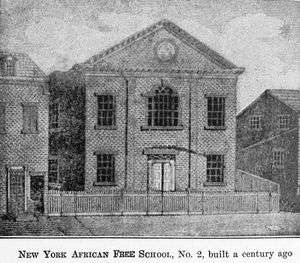John Teasman
John Teasman (1754 – 1815) was a noted American educator whose appointment as the principal of the New York African Free School (NYAFS) in 1799 was an inspiration to other black educators and to the students whose lives he touched.
John Teasman | |
|---|---|
 Lithograph of the African Free School where John Teasman worked | |
| Born | 1754 New Jersey, United States |
| Died | 1815 (aged 60–61) |
| Nationality | American |
| Occupation | Teacher |
Biography
John Teasman was born in New Jersey. Although there is not much recorded information about his early life[1] he began his career as a black educator at the New York African Free School in 1797 and he was eventually appointed by the New York Manumission Society, to the position of principal. A major objective of the New York Manumission Society was to make free blacks "useful members of the community."[2]
The African Free School began with 12 students and enrollment in the school grew rapidly. Although the student population increased, faculty salaries did not. Raising money to pay teachers was a continuing problem. In order to supplement his modest salary, Teasman began an evening school for adults. Teasman worked at the NYAFS for 10 years and under his tutelage, attendance improved by 30%.
Teasman was the first black educator to experiment with the Lancasterian method. Utilizing this method, one teacher was assisted by older students (usually called "monitors") and could instruct up to hundreds of children at a time. The Lancasterian method dramatically reduced the cost of education, which made it attractive to charitable organizations during the early 19th century.[3]
Eventually, Teasman was dismissed from his position as principal of the New York African Free School. The apparent reason for dismissal was that Teasman was unwilling to closely follow the objectives set by the trustees of the school. After leaving the NYAFS, he and his wife founded an independent school.
Teasman was politically active and encouraged other members of the African-American community to become involved and to volunteer in their communities. Along with some of the students who attended the New York African Free School, Teasman helped create the New York African Society for Mutual Relief. It is believed that this group was involved in running a station for the Underground Railroad. The society provided health insurance and death benefits for its members. Teasman also helped organize celebrations in the black community, which caused some people to argue against large numbers of blacks assembling and celebrating in New York.
John Teasman died in 1815.
References
- Anna Mae Duane and Thomas Thurston (2007). "John Teasman". New-York Historical Society. Archived from the original on September 30, 2007. Retrieved July 21, 2007.
- Swan, Robert J. (Fall 1992). "John Teasman: African-American Educator and the Emergence of Community in Early Black New York City, 1787–1815". Journal of the Early Republic. 12 (3): 331–356. doi:10.2307/3123834. JSTOR 3123834.
- Kaestle, C. F., Joseph Lancaster and the Monitorial School Movement: A Documentary History, Teachers College Press, Teachers College, Columbia University, ISBN 0-8077-2375-4 (0-8077-2375-4).